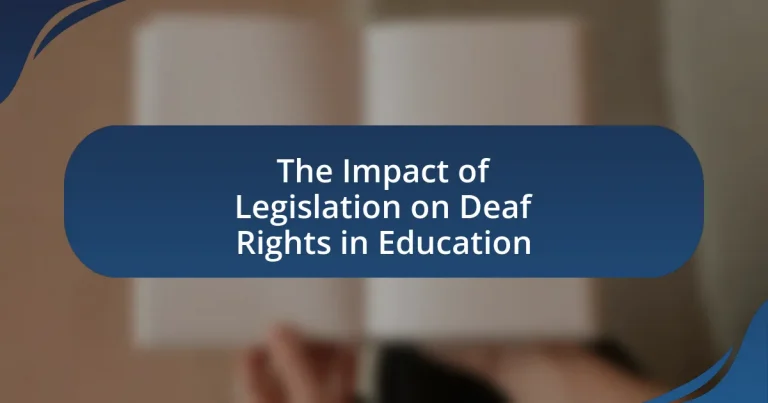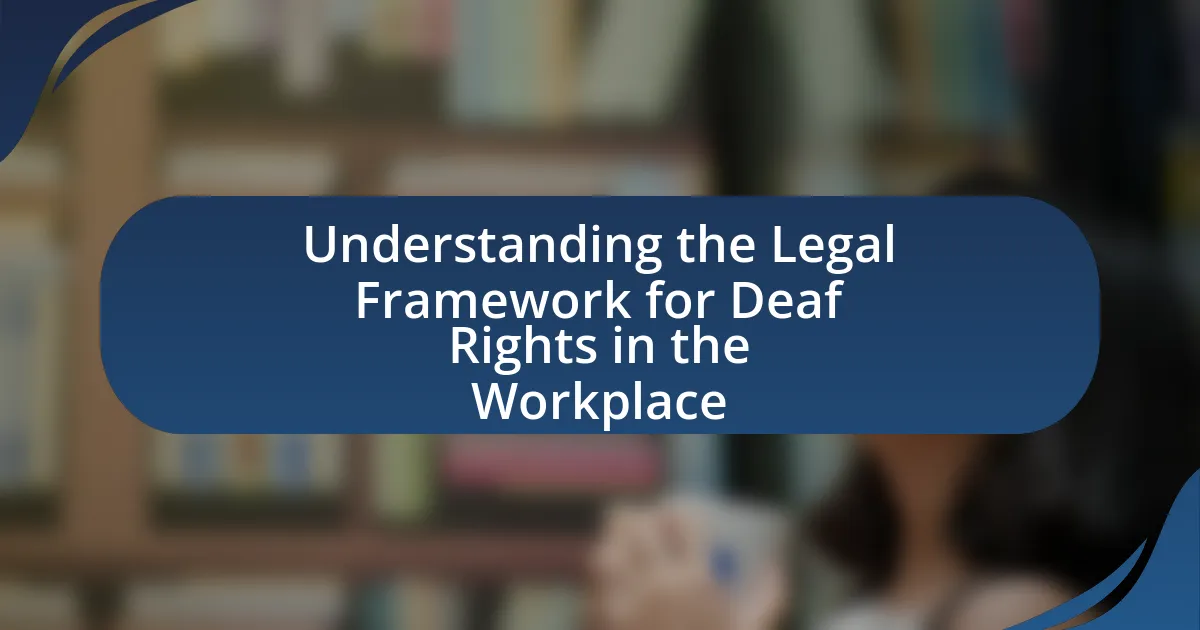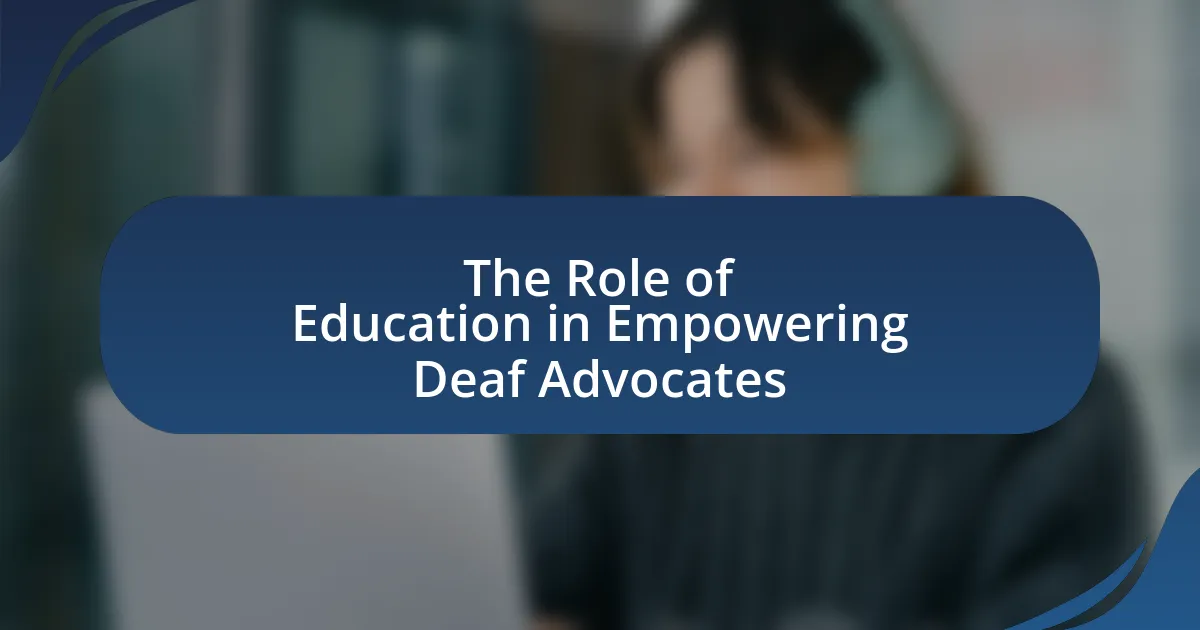The article examines the impact of legislation on deaf rights in education, highlighting key laws such as the Individuals with Disabilities Education Act (IDEA), the Americans with Disabilities Act (ADA), and Section 504 of the Rehabilitation Act. It discusses the historical evolution of these laws, their current frameworks, and the challenges faced by deaf students despite existing protections. Additionally, the article explores international approaches to deaf education, the influence of cultural attitudes, and the role of advocacy in improving educational access. It concludes by addressing future trends in legislation and best practices for enhancing the rights of deaf individuals in educational settings.
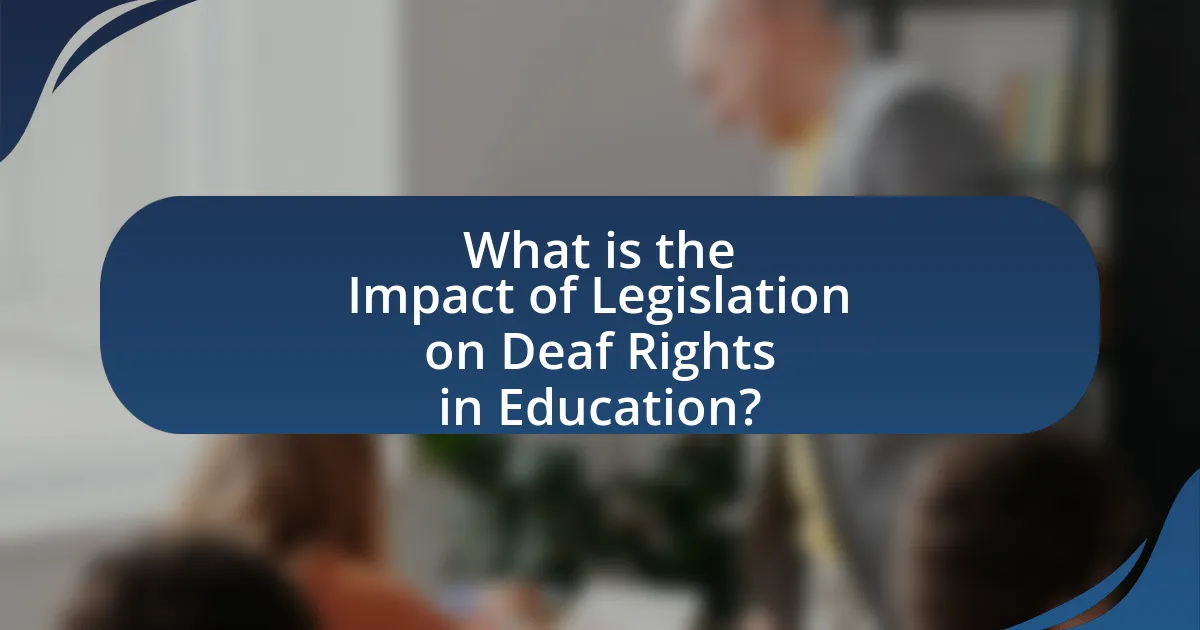
What is the Impact of Legislation on Deaf Rights in Education?
Legislation significantly impacts deaf rights in education by ensuring access to appropriate resources and accommodations. For instance, the Individuals with Disabilities Education Act (IDEA) mandates that students with disabilities, including those who are deaf, receive a free appropriate public education tailored to their individual needs. This law has led to increased funding for specialized programs and services, such as sign language interpreters and assistive technologies, which enhance educational opportunities for deaf students. Additionally, the Americans with Disabilities Act (ADA) prohibits discrimination against individuals with disabilities in educational settings, further reinforcing the rights of deaf students to participate fully in academic and extracurricular activities. These legislative frameworks collectively promote inclusivity and equal access, thereby improving educational outcomes for deaf individuals.
How has legislation historically influenced deaf rights in education?
Legislation has historically influenced deaf rights in education by establishing legal frameworks that promote access and equality for deaf individuals. The Education for All Handicapped Children Act of 1975, later known as the Individuals with Disabilities Education Act (IDEA), mandated that public schools provide free and appropriate education to all children with disabilities, including those who are deaf. This legislation was pivotal in ensuring that deaf students received specialized services and accommodations, such as sign language interpreters and tailored curricula. Additionally, the Americans with Disabilities Act of 1990 further reinforced the rights of deaf individuals by prohibiting discrimination in all areas of public life, including education, thereby enhancing their access to educational opportunities. These legislative milestones have collectively shaped the educational landscape for deaf individuals, ensuring their rights are recognized and upheld.
What key laws have shaped the educational landscape for deaf individuals?
The key laws that have shaped the educational landscape for deaf individuals include the Individuals with Disabilities Education Act (IDEA), the Americans with Disabilities Act (ADA), and Section 504 of the Rehabilitation Act. IDEA, enacted in 1975, mandates that public schools provide free and appropriate education to students with disabilities, including those who are deaf, ensuring access to specialized services and accommodations. The ADA, established in 1990, prohibits discrimination based on disability in all areas of public life, including education, thereby reinforcing the rights of deaf individuals to receive equal educational opportunities. Section 504, passed in 1973, requires schools to provide accommodations for students with disabilities, ensuring that deaf students have access to the same educational programs as their hearing peers. These laws collectively promote inclusivity and accessibility in education for deaf individuals.
How have these laws evolved over time?
Laws regarding deaf rights in education have evolved significantly from the mid-20th century to the present. Initially, the focus was on exclusion, with many deaf individuals denied access to public education. The landmark case of Brown v. Board of Education in 1954 set a precedent for educational equality, leading to the enactment of the Education for All Handicapped Children Act in 1975, which mandated free and appropriate public education for children with disabilities, including those who are deaf. This was further strengthened by the Individuals with Disabilities Education Act (IDEA) in 1990, which emphasized the importance of individualized education plans and inclusion in mainstream classrooms. Over time, advocacy for deaf rights has led to increased recognition of American Sign Language as a legitimate language and the promotion of bilingual education models. The evolution of these laws reflects a growing understanding of the rights of deaf individuals and the necessity of inclusive educational practices.
What are the current legal frameworks supporting deaf rights in education?
The current legal frameworks supporting deaf rights in education include the Individuals with Disabilities Education Act (IDEA), the Americans with Disabilities Act (ADA), and Section 504 of the Rehabilitation Act. IDEA mandates that students with disabilities, including deaf students, receive a free appropriate public education tailored to their individual needs. The ADA prohibits discrimination against individuals with disabilities in all areas of public life, including education, ensuring equal access to educational opportunities. Section 504 requires schools to provide accommodations and modifications to ensure that students with disabilities can participate fully in educational programs. These laws collectively establish the rights of deaf students to receive appropriate educational services and support.
What role does the Individuals with Disabilities Education Act (IDEA) play?
The Individuals with Disabilities Education Act (IDEA) ensures that children with disabilities, including those who are deaf, receive a free appropriate public education tailored to their individual needs. IDEA mandates that schools develop an Individualized Education Program (IEP) for each eligible child, outlining specific educational goals and the services required to achieve them. This legislation has significantly increased access to specialized resources, support services, and accommodations, thereby enhancing educational outcomes for deaf students. Since its enactment in 1975, IDEA has been instrumental in promoting the rights of students with disabilities, ensuring their inclusion in mainstream educational settings and fostering an environment conducive to learning.
How does Section 504 of the Rehabilitation Act protect deaf students?
Section 504 of the Rehabilitation Act protects deaf students by prohibiting discrimination based on disability in programs receiving federal funding, including public schools. This legislation mandates that schools provide appropriate accommodations and services to ensure equal access to education for deaf students, such as sign language interpreters, captioning, and specialized instructional materials. The U.S. Department of Education’s Office for Civil Rights enforces these provisions, ensuring that deaf students receive the necessary support to participate fully in educational activities, thereby promoting their academic success and social integration.
What challenges do deaf students face despite existing legislation?
Deaf students face significant challenges despite existing legislation, primarily due to inadequate access to resources and support services. Many educational institutions lack properly trained staff who can effectively communicate with deaf students, leading to barriers in learning and social integration. Additionally, the implementation of legislation often varies widely between regions, resulting in inconsistent access to interpreters and assistive technologies. Research indicates that only 36% of deaf students in mainstream schools receive the necessary accommodations, highlighting the gap between legal requirements and actual practice. Furthermore, societal attitudes and stigma surrounding deafness can hinder the educational experience, affecting both academic performance and emotional well-being.
How do funding disparities affect educational access for deaf students?
Funding disparities significantly limit educational access for deaf students by reducing the availability of specialized resources and services. Schools with inadequate funding often lack qualified staff, such as interpreters and teachers trained in deaf education, which directly impacts the quality of education that deaf students receive. According to the National Center for Education Statistics, schools serving a higher percentage of low-income students, including many deaf students, receive less funding per pupil, leading to fewer educational opportunities and support services. This inequity results in lower academic achievement and higher dropout rates among deaf students, as they are unable to access the same level of educational resources as their hearing peers.
What barriers exist in the implementation of deaf rights legislation?
Barriers in the implementation of deaf rights legislation include inadequate funding, lack of trained professionals, and insufficient awareness among educators and policymakers. Inadequate funding limits the resources available for implementing necessary accommodations and services for deaf individuals, which directly affects their educational opportunities. The lack of trained professionals, such as interpreters and special education teachers, hinders the effective delivery of education tailored to the needs of deaf students. Additionally, insufficient awareness among educators and policymakers about the specific rights and needs of deaf individuals can lead to non-compliance with existing legislation, further obstructing the implementation process. These barriers collectively undermine the effectiveness of deaf rights legislation in promoting equitable education for deaf individuals.
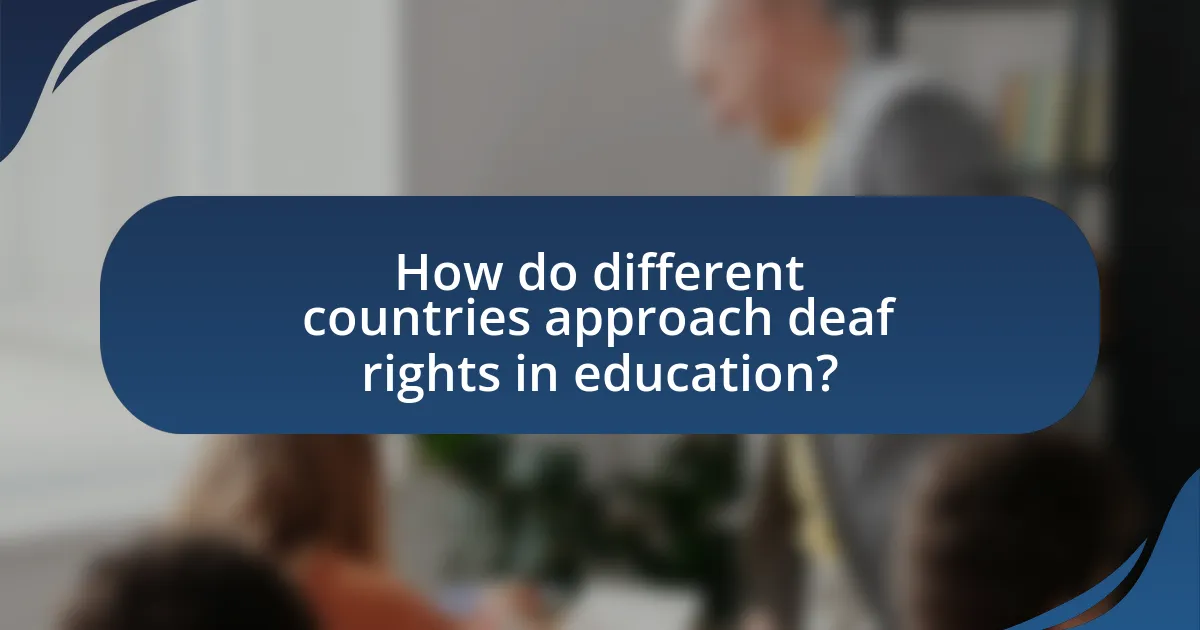
How do different countries approach deaf rights in education?
Different countries approach deaf rights in education through varying legislative frameworks and policies that prioritize accessibility and inclusion. For instance, the United States has the Individuals with Disabilities Education Act (IDEA), which mandates that students with disabilities, including those who are deaf, receive a free appropriate public education tailored to their individual needs. In contrast, Sweden emphasizes the right to bilingual education, promoting both Swedish Sign Language and Swedish for deaf students, reflecting a commitment to cultural identity. Meanwhile, in Australia, the Disability Discrimination Act ensures that educational institutions provide reasonable adjustments for deaf students, fostering an inclusive environment. These legislative approaches demonstrate a global recognition of the importance of equitable education for deaf individuals, with specific laws and policies designed to support their unique needs.
What are the key differences in legislation across various countries?
Key differences in legislation across various countries regarding deaf rights in education include the recognition of sign language, the provision of interpreters, and the implementation of inclusive education policies. For instance, in the United States, the Individuals with Disabilities Education Act mandates free appropriate public education for students with disabilities, including those who are deaf, and emphasizes the use of sign language when appropriate. In contrast, countries like Sweden have a strong legal framework that recognizes Swedish Sign Language as a minority language, ensuring its use in educational settings. Additionally, Australia’s Disability Discrimination Act requires educational institutions to make reasonable adjustments for students with disabilities, including access to sign language interpreters. These variations reflect differing cultural attitudes towards disability and the rights of deaf individuals, influencing the effectiveness of educational access and support across nations.
How do international treaties influence national laws regarding deaf education?
International treaties significantly influence national laws regarding deaf education by establishing standards and obligations that countries must adhere to. For instance, the United Nations Convention on the Rights of Persons with Disabilities (CRPD), adopted in 2006, mandates that sign language and other forms of communication be recognized and promoted in educational settings. This treaty compels signatory nations to align their national legislation with its provisions, thereby enhancing access to quality education for deaf individuals. Countries that ratify such treaties often amend their laws to ensure compliance, which can lead to improved educational resources, teacher training, and inclusive practices for deaf students.
What can be learned from countries with successful deaf education policies?
Countries with successful deaf education policies demonstrate that inclusive education, access to sign language, and early intervention significantly enhance educational outcomes for deaf students. For instance, Finland’s education system emphasizes bilingual education, where Finnish Sign Language is used alongside Finnish, resulting in higher literacy rates among deaf students compared to countries with less inclusive practices. Additionally, research from the World Federation of the Deaf indicates that countries with comprehensive deaf education policies, such as Sweden and Denmark, show improved social integration and employment opportunities for deaf individuals, highlighting the long-term benefits of effective educational frameworks.
How do cultural attitudes impact the effectiveness of legislation for deaf rights?
Cultural attitudes significantly impact the effectiveness of legislation for deaf rights by shaping public perception and acceptance of deaf individuals and their needs. When society holds positive attitudes towards deaf culture and sign language, legislation is more likely to be supported and effectively implemented, as seen in countries like Sweden, where inclusive policies have been adopted due to a strong cultural recognition of deaf rights. Conversely, negative attitudes can lead to inadequate enforcement of laws and insufficient resources for deaf education, as evidenced in regions where deaf individuals face stigma, resulting in lower educational outcomes and limited access to services. Thus, the alignment of cultural attitudes with legislative goals is crucial for the advancement of deaf rights in education.
What role does societal perception play in the enforcement of deaf education laws?
Societal perception significantly influences the enforcement of deaf education laws by shaping public attitudes and policy priorities. When society views deaf individuals positively and recognizes their rights to equitable education, lawmakers are more likely to implement and enforce comprehensive deaf education policies. For instance, the Individuals with Disabilities Education Act (IDEA) in the United States was strengthened partly due to growing awareness and advocacy for the rights of individuals with disabilities, including the deaf community. Research indicates that increased visibility and acceptance of deaf culture lead to more robust legislative support, as seen in the rise of educational programs tailored for deaf students, which reflect societal values that prioritize inclusivity and accessibility.
How can advocacy improve the situation for deaf students in different cultures?
Advocacy can significantly improve the situation for deaf students in different cultures by promoting inclusive educational policies and raising awareness about their rights. For instance, advocacy efforts can lead to the implementation of legislation that mandates access to sign language interpreters and specialized educational resources, which are crucial for effective learning. In countries like the United States, the Individuals with Disabilities Education Act (IDEA) ensures that deaf students receive appropriate accommodations, demonstrating how advocacy can influence policy to enhance educational access. Furthermore, advocacy can challenge cultural stigmas surrounding deafness, fostering a more supportive environment for deaf students. Research indicates that increased advocacy correlates with improved educational outcomes for deaf students, as seen in various international studies highlighting the positive impact of inclusive practices on academic achievement.
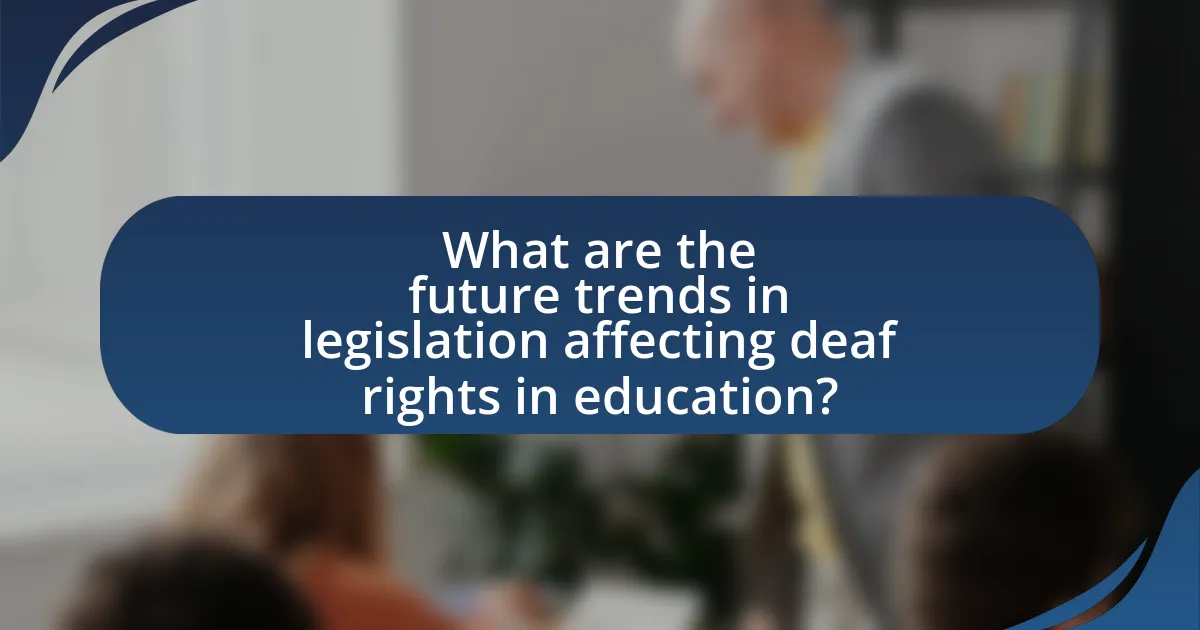
What are the future trends in legislation affecting deaf rights in education?
Future trends in legislation affecting deaf rights in education include increased emphasis on inclusive education practices and the integration of technology to support learning. Legislative movements, such as the reauthorization of the Individuals with Disabilities Education Act (IDEA), are likely to focus on ensuring that deaf students receive appropriate accommodations and access to resources, including sign language interpreters and assistive technologies. Additionally, there is a growing trend towards recognizing the importance of cultural identity and language rights for deaf individuals, which may lead to policies that promote bilingual education models that incorporate both sign language and spoken language. These trends are supported by advocacy from organizations such as the National Association of the Deaf, which emphasizes the need for equitable access to education for deaf students.
How is technology influencing legislative changes for deaf education?
Technology is significantly influencing legislative changes for deaf education by enabling more accessible communication methods and educational resources. Innovations such as video relay services, real-time captioning, and mobile applications have prompted lawmakers to recognize the necessity of integrating these tools into educational frameworks. For instance, the Individuals with Disabilities Education Act (IDEA) has evolved to include provisions that require schools to utilize technology to support the learning of deaf students, ensuring they receive appropriate accommodations. This shift is supported by data indicating that access to technology improves educational outcomes for deaf students, thereby reinforcing the need for legislative updates that reflect these advancements.
What innovations are being integrated into educational policies for deaf students?
Innovations being integrated into educational policies for deaf students include the implementation of technology-enhanced learning tools, such as real-time captioning and video relay services. These tools facilitate better communication and access to information in classrooms, ensuring that deaf students can engage fully with their education. For instance, the use of mobile applications that provide sign language interpretation and the incorporation of virtual reality environments for immersive learning experiences have been recognized as effective strategies. Research indicates that these innovations lead to improved academic outcomes and social integration for deaf students, as evidenced by studies showing increased engagement and participation in classroom activities.
How might future legislation address emerging challenges for deaf students?
Future legislation may address emerging challenges for deaf students by mandating the inclusion of advanced communication technologies and ensuring access to qualified interpreters in educational settings. Such legislation could require schools to implement real-time captioning and sign language resources, which are essential for effective learning and participation. For instance, the Individuals with Disabilities Education Act (IDEA) already emphasizes the need for appropriate accommodations, and future amendments could expand these requirements to encompass digital learning environments, reflecting the increasing reliance on technology in education. This approach would help mitigate barriers that deaf students face, ensuring equitable access to educational opportunities and resources.
What best practices can be adopted to enhance deaf rights in education?
To enhance deaf rights in education, implementing inclusive teaching practices is essential. These practices include providing qualified sign language interpreters, ensuring access to assistive technologies, and developing individualized education plans (IEPs) tailored to the specific needs of deaf students. Research indicates that schools with trained staff in deaf education and a commitment to inclusive policies see improved academic outcomes for deaf students, as evidenced by a study published in the Journal of Deaf Studies and Deaf Education, which found that deaf students in inclusive settings performed better academically and socially. Additionally, fostering collaboration between educators, parents, and the deaf community can further support the rights and needs of deaf students, ensuring their voices are heard in educational decision-making processes.
How can educators effectively implement legislation to support deaf students?
Educators can effectively implement legislation to support deaf students by ensuring compliance with laws such as the Individuals with Disabilities Education Act (IDEA) and the Americans with Disabilities Act (ADA). These laws mandate that educational institutions provide appropriate accommodations, such as sign language interpreters and accessible learning materials, to facilitate equal access to education for deaf students. Research indicates that schools that actively engage in training staff on these legal requirements and promote inclusive practices see improved educational outcomes for deaf students, as evidenced by a study published in the Journal of Deaf Studies and Deaf Education, which highlights the positive correlation between legislative adherence and student achievement.
What role do parents and communities play in advocating for deaf rights in education?
Parents and communities play a crucial role in advocating for deaf rights in education by actively engaging in policy discussions, raising awareness, and supporting legislative initiatives that promote equal access to education for deaf students. Their involvement is essential in shaping educational policies, as they provide firsthand accounts of the challenges faced by deaf individuals, which can influence lawmakers and educational institutions. For instance, organizations like the National Association of the Deaf (NAD) emphasize the importance of parental advocacy in securing appropriate resources and accommodations, demonstrating that collective efforts can lead to significant legislative changes, such as the Individuals with Disabilities Education Act (IDEA), which mandates that students with disabilities, including those who are deaf, receive a free and appropriate public education.
